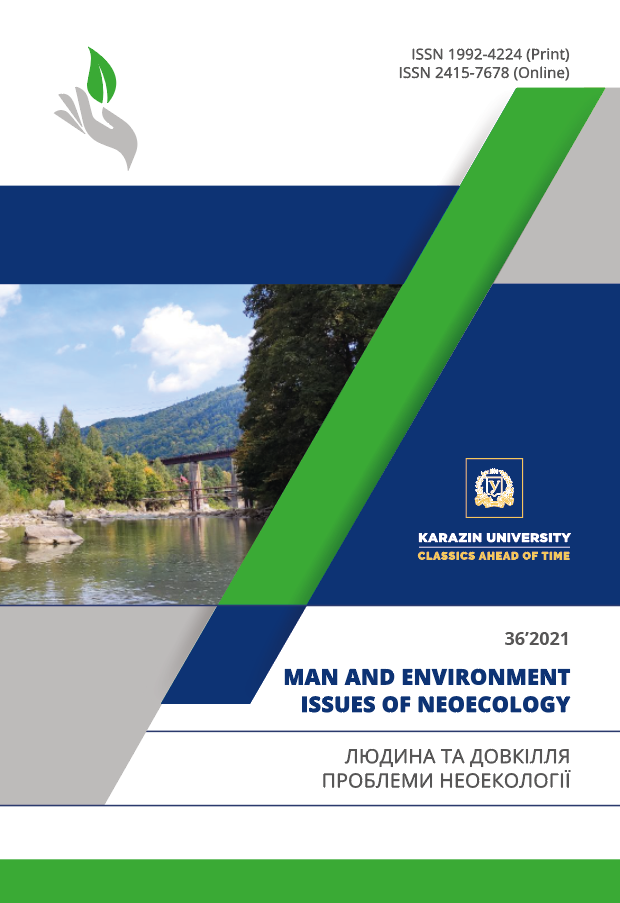System of Diagnostic Indicators for Low-Productive and Degraded Soils to Assess Their Suitability for Afforestation
Abstract
Purpose. The identification of soil indicators for assessing the forest growth potential of soils for the possibility of afforestation.
Methods. The indicators were chosen among the soil parameters most often used to assess fertility: reserves and thickness of forest litters, morphological characteristics of soils, particle size distribution, acidity, humus and various forms of NPK content, composition and content of exchangeable cations. The research was carried out in natural medieval forests according to the methods generally accepted in forest inventory, typology, soil science, analytical work - according to classical agrochemical and standardized methods.
Results. The article gives an analysis of the problem of forestry typological evaluation of low-output and degraded soils (sandy, with shortened profile, salted, eroded), which were withdrawn from agricultural usage. The actual and theoretical material on the basis of which the range of issues related to the evaluation of forest land use in different natural zones is generalized, was collected and analyzed. On the main categories of low-productive lands in different natural zones of the flat part of Ukraine temporary trial areas were laid, where soil and typological investigation were conducted. The soil indicators and parameters of forest productivity of low productivity and degraded soils are determined, on the basis of which the classification of soils based on the degree of their suitable for afforestation has been developed. The suitability of soils for afforestation were evaluated in three categories: suitable for afforestation, limitedly suitable and unsuitable suitable for afforestation.
Conclusions. The experience of afforestation of low-productive and degraded soils is generalized and a system of diagnostic indicators for their forest typological evaluation on zonal and morphological basis is proposed, and an information analysis on the problem of assessing the suitability for afforestation of low-productive lands (saline, stony, sandy) that are derived from agricultural circulation is provided. The suitability of soils for afforestation is described by a system of soil indicators, in particular, their particle size distribution, humus content, common and mobile forms of NPK, and exchangeable cations. However, among these indicators, one can single out informative indicators of the level of productivity of forest lands - mineralogical (chemical) and granulometric composition of soils. At the same time, it has been proved that the granulometric composition of the soil determines such important characteristics as the content of exchange bases, common forms of phosphorus, potassium, and humus.
Downloads
References
State target program "Forests of Ukraine" for 2010-2015. (2009). Resolution of the Cabinet of Ministers of Ukraine. Retrieved from https://zakon.rada.gov.ua/laws/show/977-2009-%D0%BF#Text
Timchenko, D. O., Gichka, M. M., Kutsenko, M. V., … Lisnyak, A. A. (2010). Scientific and Applied Fundamentals of Soil Protection against Erosion in Ukraine. Monograph. Kharkiv: NTU "KhPI". (In Ukrainian).
Lisnyak, A., Vilcek, J. & Torma, S. (2013). Súčasný stav erodovaných pôd ukrajinských lesostepí na príklade lokalis mitříší ovrag. Vedecke praсe. Vyskumneho ustavu podoznalectva a ochrany pody. (35), 107-115. (In Slovak).
Lisnyak, A., Vilcek, J. & Torma, S. (2016). The post-degradation of forest ecosystems on land removed from agricultural use. Innovative technologies and intensification of development of national production: materials of the III International Scientific and Practical Conference. Part 1. 162-164.
Lisnyak, A. A., Utkina, K. B. & Garbuz, A. G. (2018). Present status of east Forest-Steppe of Ukraine with reference to ravine-beam system of «Mitrishin Ovrag». Folia Geographica. 60(1), 62-73. Retrieved from http://www.foliageographica.sk/unipo/journals/2018-60-1/2
Polupan, M. I., Solovei, V. B., Kisil, V. I. & Velichko, V. A. (2005). The eco-genetic status and soil fertility determiner of Ukraine. A manual. Kiev: Koloobih. (In Ukrainian).
Torma, S., Vilček, J., Lošák, T., Kužel, S. & Martensson, A. (2017). Residual plant nutrients in crop residues – an important resource. Acta agriculturae scandinavica, Section B – Soil & Plant Science, 68(4). 358-366. http://dx.doi.org/10.1080/09064710.2017.1406134
Svetlichny, A. A., Chornyi, S. G. & Schwebe, G. I. (2004). Erosion Sciences: Theoretical and Applied Aspects: Monograph. Sumy: University book. (In Ukrainian).
Sobolev, S. S. (1954). Nomenclature of washed (eroded) soils. Soil studies and compilation of soil maps. 13-24. (In Russian).
Medvedev, V. V. & Plisko, I. V. (2006). Bonitation and qualitative estimation of arable lands of Ukraine. Kharkiv: 13 printing house. (In Ukrainian).
Pogrebnyak, P. S. (1955). Fundamentals of forest typology. Kyiv: USSR Academy of Sciences. (In Ukrainian).
Donchenko, M. T., (1971). Forest Growth Properties of Soils at Non-carbonate carbonous rock of the Central Donbass. Author's abstract. Dis Cand. Agricultural Sciences: 06.532. Kharkiv agricultural university named after V.V. Dokuchaev. (In Ukrainian).
Vilček, J. & Torma, S. (2016). Characterization of Soil in Slovakia for Sugarbeet (Beta vulgaris. L.) Cultivation Using Geografic Information Systems (GIS). Sugar Tech 18(5). 488-492. http://dx.doi.org/10.1007/s12355-015-0419-5
Vilček, J. & Torma, S. (2016). Winter wheat (Triticum aestivum L.) growth potential in the Slovak rural landscape. Archives of agronomy and soil science. 62(2). 235-245. http://dx.doi.org/10.1080/03650340.2015.1043899
Vilček, J. & Koco, Š. (2018). Integrated index of agricultural soil quality in Slovakia. Journal of Maps.
(2), 68-76. http://dx.doi.org/10.1080/17445647.2018.1428233
Authors reserve the right of attribution for the submitted manuscript, while transferring to the Journal the right to publish the article under the Creative Commons Attribution License 4.0 International (CC BY 4.0). This license allows free distribution of the published work under the condition of proper attribution of the original authors and the initial publication source (i.e. the Journal)
Authors have the right to enter into separate agreements for additional non-exclusive distribution of the work in the form it was published in the Journal (such as publishing the article on the institutional website or as a part of a monograph), provided the original publication in this Journal is properly referenced
The Journal allows and encourages online publication of the manuscripts (such as on personal web pages), even when such a manuscript is still under editorial consideration, since it allows for a productive scientific discussion and better citation dynamics (see The Effect of Open Access).





